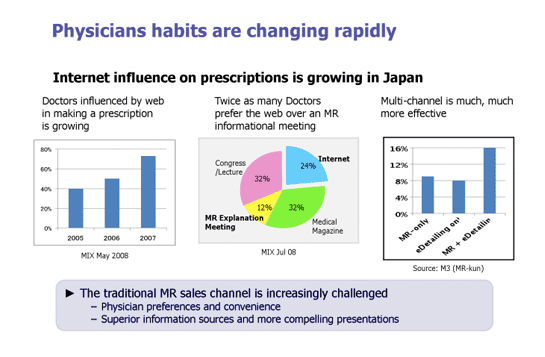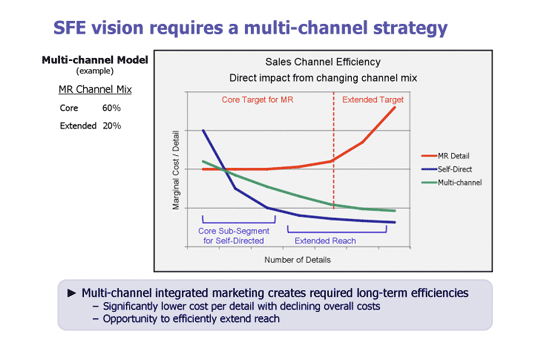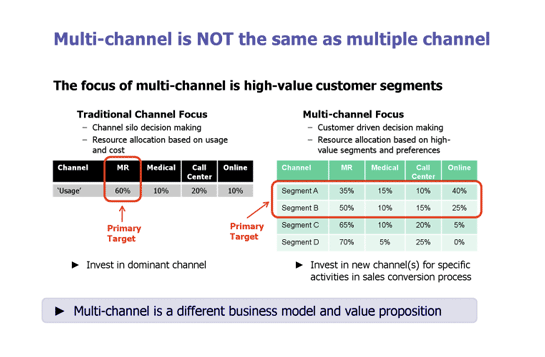
Keywords
customer relationship marketing (CRM)
digital marketing
multi-channel marketing
performance metrics
strategic agenda
March 16, 2010
Innovation Memo: Pharmaceutical Marketing Performance Strategy
The sky is falling!
Large pharmaceutical companies ('Big Pharma') are struggling with the demise of the blockbuster-drug business model. For a long time, at most 3 out of 10 drugs paid back their investment and created all of the profits.
Now, the continued low ROI from R&D investments, limited prospects for new blockbuster drugs, and looming patent expirations are the impelling factors in the industry globally.
Faced with an uncertain future, Big Pharma is engaged in global consolidation and rampant cost-cutting. These actions seem like limited-goal 'survivor' tactics as they lack a clear vision of a transformed business model for the new environment.
Perspective
The perspective offered here relates to the implications of the changing product mix, coupled with changing customer preferences, on marketing strategies. The viewpoint builds on experience in Japan with an international Pharma company where the focus was the creation and early implementation of a multi-channel marketing strategy.
The implementation had a broad range of pilot programs with impressive results and solid ROIs. This viewpoint began in response to the sponsoring executive questioning why, with the demonstrated track record, there wasn't a greater demand across all of marketing and sales for expanding the multi-channel programs.
An easy answer is a change resistant corporate culture that is much slower to adopt new ways than executives would like. Another simple answer is the lower urgency for Japan Pharma operations. With an average 5-year lag in drug approvals compared to Western countries, the medium-term pipeline prospects in Japan are not as dire.
One medium-term strategic projection showed rapid sales growth fueled by prospective new drug approvals. However, a closer look at the operating assumptions reveals a fundamental performance issue that transcends culture and local circumstances; and one suspects the slow response to multi-channel marketing is more reflective of general industry conditions.
Case for Action
The largest part of the Pharma marketing budget is dedicated to the field-sales armies of Marketing Representatives (MR). Without new blockbuster drugs, the product portfolio mix will increasingly skew toward lower volume, more specialized medicines: and a proliferation of lower volume products will not sustain the feet-on-the-street marketing approach.
Consequently, the Japan strategic growth projection referenced above required a doubling of the sales force efficiency (SFE). With the sales capabilities implied from the portfolio mix change, the scale of improvement required, and the rapidly diminishing timeframe, this efficiency gain cannot be expected to happen organically or in marginal increments.
The need for a dramatically more cost efficient, more effective marketing approach is the key internal driver for a strategic change. At the same time, rapidly changing customer (i.e., physician) preferences underscore the need from an external point of view.
Much has been reported about Medical Representative reduced face-time with physicians and the increasing number of hard-to-reach or unavailable physicians. A major factor for the diminishing sales force effectiveness is their reduced relevance in the Internet age. Physicians in Japan, as elsewhere, are following the general trends toward using the Internet as the number one source of information.

The fundamental portfolio mix trend and the changing customer profile are certainly global and not limited to Japan. The solution framework for Big Pharma has to address both the internal needs for improved SFE and the external demands of the direct customers (physicians) for more flexible access to relevant drug information and services. The sample of statistics shown above point toward a multi-channel solution, based on both preferences and effectiveness.
Multi-Channel Marketing ROI
Simply put, multi-channel marketing is integrated marketing communications across all channels. The threshold goal is the potential efficiency offered by effective blend of sales force and digital media. The illustrative model shown in the graph below indicates how multi-channel can achieve the cost efficiencies required by the changing environment.
The cost curve for the MR sales force will increase whenever the target customer contact base is extended. The variable manpower cost will tend to increase exponentially for any plan to achieve either extra time with doctors or incremental reach. On the other hand, digital media with mostly fixed costs will show a declining cost curve (i.e., improving cost efficiency) as reach increases. Consequently, balanced multi-channel marketing can offer the requisite efficiencies and a substantial ROI.

Hurdles for Innovation
Achieving the SFE vision, as graphically represented above, requires transformational innovation in the downstream marketing business model. And a prerequisite for dramatic success will a clear acknowledgment of the scope of the undertaking.
First, there is an industry-wide organizational bias that has to be recognized. Pharma companies, in general, can be described as "back-to-front" when compared to other industries.
Other industries, particularly those that are consumer-oriented, are marketing led. Pharma is sales-force centric with marketing largely in a support role. The sales force bias is reinforced in Japan as a new MBA hired into marketing typically will start by spending two years or so as an MR in the field.
Second, multi-channel is not the same as multiple channel. The large international pharmaceutical companies are reportedly spending about 10% of their marketing budget on digital channels and have an alphabet of related programs to improve efficiency. However, these efforts appear to be more multiple channel efforts, too often falling into the trap of"all things to all people all of the time".
The principle for multi-channel is a focus on high-value customer segments and the underlying belief that multi-channel interactions are a key driver for customer engagement. In a marketing-led setting, the first question is what conversations do we want to have with which customers, and the second question is what channel is most appropriate.
Therefore the biggest hurdle for a multi-channel strategy is aligning on the different business model and value proposition. Strategic execution of a transformational agenda will require a different set of business goals and performance metrics across all of the marketing-related areas.

Strategic Innovation Agenda
Looking at Big Pharma more broadly in relation to other industries, the current situation can be viewed as a typical innovation cycle. For example, a common development pattern for technology products is from hardware to software to integrated solution to services. From this perspective, the Pharma marketing innovation agenda is to move from pushing physical products toward pulling customers through a new 'service' model.
Broadly rethinking the value proposition will inform the development of a new multi-channel sales/conversion model and marketing program planning. Execution can be approached from two view points:
- Strategic: performance management based on a new focus and metrics;
- Tactical: multi-channel integrated marketing based on a new marketing playbook.
Both would necessarily be customer-centric (i.e., 'outside-in') with an overall strategic view that challenges today's conventional thinking. However, a more tactical emphasis will lead to the 'slow' change that the Japan executive was observing.
Rapid transformational change usually occurs only when there is a 'burning platform' - essentially when it is apparent that radical change is the only choice for survival. The signs of a burning platform seem to be increasingly evident, but whether the industry or especially the Japan segment is being sufficiently cognizant is open to question.
For further information, please contact